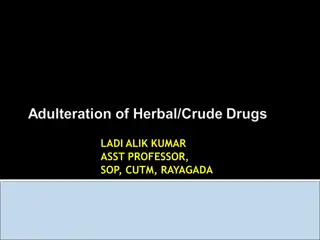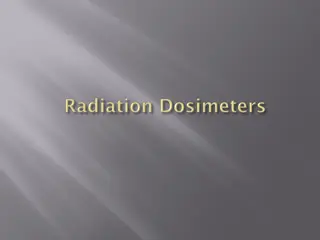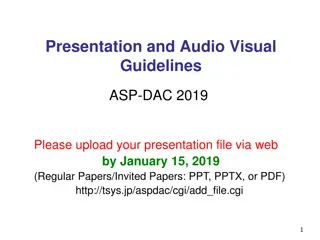Exploring Time and Memory in Christopher Nolan's Memento
Dive into the intricate narrative of Christopher Nolan's film "Memento," where time and memory play pivotal roles in the protagonist's quest for revenge amidst amnesia. Analyze Deleuze's time-image concept in relation to the film's complex temporal movements and characters who have lost their memories, shedding light on the unique storytelling techniques employed by Nolan.
Download Presentation

Please find below an Image/Link to download the presentation.
The content on the website is provided AS IS for your information and personal use only. It may not be sold, licensed, or shared on other websites without obtaining consent from the author. Download presentation by click this link. If you encounter any issues during the download, it is possible that the publisher has removed the file from their server.
E N D
Presentation Transcript
Time Images in Christopher Nolan and Ali Smith
Memento (2000), dir. Christopher Nolan Memento -- Opening Leonard, left amnesiac after a violent attack in which his wife was killed, is trying to identify her killer and take revenge. He cannot establish new memories, however, so can never be sure about the new information he receives, about others deeds and identities, and his own. He has written and tattooed information related to the crime on his own body. Watch the opening titles and first few minutes of Memento. Where might Deleuze s time-image be manifest? How might we read this film in relation to the ideas about time explored so far?
Time and post-war cinema (Deleuze, Cinema 2 False continuity False movements The time-image Time that appears for itself Time developed or revealed Image that reveals relationships of time Characters that have lost their memories Complex temporal movements An oppressive, useless and unsummonable time
Christopher Nolan, director, on the story behind Memento and the narrative technique of the film: https://www.youtube.com/watch?reload=9&v=67e_jl4flpE
Deleuze on cinema (see Ronald Bogue, Deleuze on Cinema, pp. 2-8) the things we commonly call space and time are merely extremes of the contraction and dilation of a single dur e, or duration. [the universe as flow ] contracts to form the fixed and discrete entities of the spatial world and dilates to form the temporal dimension of a universal past surging through the present and into the future. The sensori-motor schema (how we perceive the world in relation to how we (and other things) move in it) provides the common-sense temporal and spatial coordinates of our everyday world, and the signs of the movement- image, which are the signs of the classic cinema, ultimately conform to the coordinates of that common-sense world (action, cause-and-effect, journeys, quests, productivity etc. movement-images that conform to this schema),
Time-image in modern cinema If there is a unity to the new German cinema Wenders, Fassbinder, Schmid, Schroeter, or Schlondorff it is also here, as a result of the war, in the constantly variable link between these elements: spaces reduced to their own descriptions (city- deserts or places which are constantly being destroyed), direct presentations of an oppressive, useless and unsummonable time which haunt the characters; and, from one pole to the other, the powers of the false which weave a narration, in so far as they take effect in 'false movements'. (Deleuze, Cinema 2, 136)
Time-image becomes more prominent in post-war [art] cinema: [the] time-image has nothing to do with a flashback, or even with a recollection. Recollection is only a former present, whilst the characters who have lost their memories in modern cinema literally sink back into the past, or emerge from it, to make visible what is concealed even from recollection. [ ] Flashback [gives way to] much more complex temporal movements. (Deleuze, Cinema 2, xii)
Melissa Clarke, Space-Time Image: The Case of Bergson, Deleuze and Memento Leonard meets a series of people, and we are given a plausible explanation of how he knows them. Later in the film, however, doubt is cast on these explanations. The irresolvability of truth in the [different] presents shows each is contingent on its connection with one among several alternative, coexisting pasts. (Clarke, 176) Those gaps in Leonard s memory still exist as parts of the social past , however, as pasts to his present, whether or not he can remember them. Duration persists even in the face of the failure of individual memory.
The viewpoint of the film is the perspective of this universal duration, from which perspective time travelling backwards, as it does in the film, is as possible as it travelling forwards. Cf. also Claire Colebrook, The Joys of Atavism on Bergson s modernism of inhuman time , the perspective of universal duration. [cf. Peter Walsh s reverie on the old woman s voice ancient past appearing in Mrs Dalloway]
Gilles Deleuze and Film Theory [Deleuze s film philosophy] attempts to belong to cinema rather than simply be about it. It shows us film thinking for itself. Film-makers, for Deleuze are like philosophers, except that they think with movement-images and time-images instead of concepts (Deleuze 1989: 280) The narrative arc of Deleuze s two-volume work on cinema, Cinema 1 and Cinema 2: there was once a cinematic image adequate to expression that then fell into crisis (the shattering of the movement-image) before its resurrection as a time-image, an image adequate to its time, even when it is a time of loss and decay. First act (Cinema 1), last act (Cinema 2), with the middle act coming in the transition between the two books. Deleuze isn t interested, as much film theory is, in the gaze, the point of view of either the viewer or director. His images are in and for themselves; films think , not just us. (Cf. Bergson, whose subjectivity of time is really a relativity of time the world, as well as we, are passing through duration, which is universal. We see the world differently because of our speed, movement, environment, not just an internal driver like emotion.) [His film theory] is a phenomenology that transcends normal , anthropomorphic, perception, showing us how things see themselves (and us), rather than how we (normally) see them. (Nasrullah Mambrol, Gilles Deleuze and Film Theory , literariness.org https://literariness.org/2018/08/06/gilles-deleuze-and-film-theory/)
Mambrol on the movement-image The moving images on screen (a quantity) extend to an off-screen set of images (a quality). Indeed, in the simple shot we see the essence of the cinematic movement-image: it lies in the extraction from moving bodies the movement which is their common substance, or extracting from [quantitative, partial] movements the [qualitative, holistic] mobility which is their essence (ibid.: 23). This movement produces a qualitative feeling, a whole world, simply created from the way an actor might silently raise a hand during an otherwise static shot, or, in a modern movie,when a camera cranes high into the sky above its subject. This thread or relation between part and whole is expressed even more clearly with the use of editing techniques, be it in the American, organic , style of editing, Soviet dialectical montage, the quantitative style of pre-war French film- makers, or the intensive cutting of the German Expressionists (ibid.: 29-55). Montage a new, aberrant, connection between images releases even more the qualitative, holistic movement from the local (on-screen) movement-images in an indirect image of time . The action-image, on the other hand, expresses the well-organized, sensory-motor relationship between characters and the story-worlds that they inhabit. It is best typified by classical Hollywood narrative and the acting methods accompanying it (although, for Deleuze, narrative is derived from the images, not the other way round).
Bogue, Deleuze on Cinema, p. 7 The gap between images functions as the principle of their interconnection, and in each gap the fissure of a pure outside is made present. The outside is a split in chronometric time and Newtonian space that escapes common-sense rationality we see and enter into a world of thought-images beyond ordinary thought. In the modern cinema as well the gap between images is doubled by a gap between images and sounds, and that gap requires that visual and sonic signs be read in ways that cannot be anticipated in advance of their appearance. the lectosigns of the modern cinema are genuinely audio-visual signs, sounds constituting an autonomous sonic continuum, images a separate visual continuum, and the two put/ in relation to one another through their mutual differences
Ali Smith, The Accidental [Astrid s dream] "If she can get this on film she will be able to show someone everything that's happening. But she can't lift the camera. It is too heavy" (14-18) Supermarket cameras; throwing camera off motorway bridge (113-118) [Amber not on Astrid s pictures] [T]here was nothing. It was as if Amber had deleted herself, or was never there in the first place and Astrid had just imagined it (225-227).























